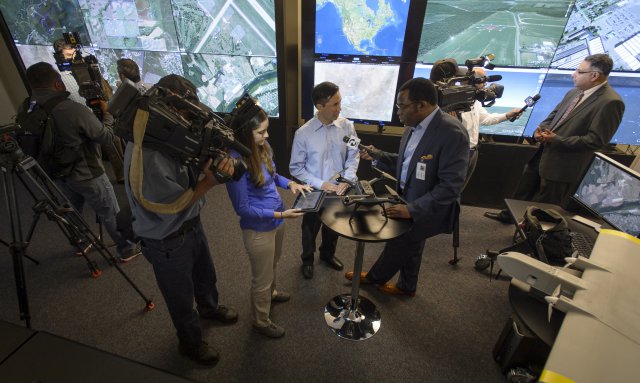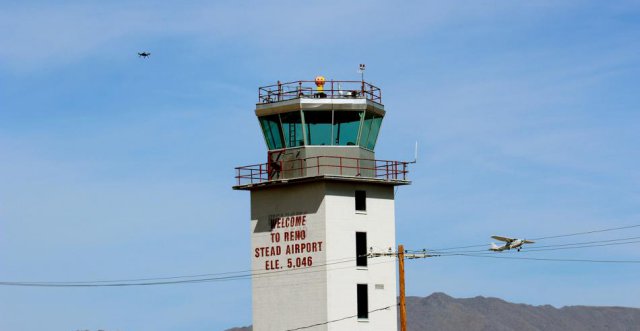
San Francisco Bay Area reporters interview NASA researchers and observe the FAA test sites fly 24 drones to test air traffic management platform at NASA’s Ames Research Center in Silicon Valley, California
In the first and largest demonstration of its kind, NASA and operators from the Federal Aviation Administration’s (FAA) unmanned aircraft systems (UAS) test sites across the country flew 22 drones simultaneously to assess rural operations of NASA’s UAS traffic management (UTM) research platform.
Operators outside NASA interacted with the UTM research platform, entering flight plans and planned operations from several geographically diverse locations, using various aircraft and software. The UTM research platform checked for conflicts, approved or rejected the flight plans and notified users of constraints. Engineers at NASA’s Ames Research Center in Silicon Valley, California, monitored operations and system load and gathered qualitative feedback to identify capability gaps to further refine the UTM research.
“We didn’t have any testing problems today,” said Parimal Kopardekar, manager of NASA’s Safe Autonomous Systems Operations project and lead of NASA’s UTM efforts. “NASA extensively tested Technical Capability Level one and worked very closely with the FAA test sites, and the UTM research platform performed well. This test would not have been possible without the six FAA test sites – it was a collaborative effort to ensure a successful test.”
A total of 24 drones flew multiple times throughout the three-hour test, with 22 flying simultaneously at one point. The mission was declared successful, given the minimum success criteria of 16 simultaneous operations was achieved. In addition to the live aircraft interacting with UTM, NASA Ames introduced dozens of virtual aircraft into the same airspace to further enhance the test. This mixing of live flights with virtual flights provided additional insight for future tests to refine the UTM concept.
Conducting a successful test required hours of coordination and logistics. Weather conditions at each of the test sites provided an additional challenge as drones cannot fly in rain or high winds, so engineers monitored weather conditions across the country to ensure the drones could fly. Winds are often greater in the afternoon, so the optimum flight window was 7 a.m. – 3 p.m. PDT. The forecast the prior day predicted a 40% chance of rain for two locations, but the weather cooperated, and all sites – Fairbanks, Alaska; Grand Forks, North Dakota; Reno, Nevada; Rome, New York; Virginia Tech’s locations in Blacksburg, Virginia, and Bushwood, Maryland; and Corpus Christi, Texas – flew during the test.
“After so much preparation and practice, it was very rewarding to see all test sites have success with weather, platforms and connectivity,” said Tony Basile, director of operations at NUAIR and New York test site manager. “It was additionally rewarding to hear from NASA that today’s efforts were successful on their end as well.”
Joseph Rios, flight test director and UTM technical lead explained, “NASA built the research platform and tested it on a local scale, but we needed the experience and expertise at each of the FAA test sites to exercise the platform in this geographically diverse way. Their efforts and skills in managing field deployments were pivotal to the success of this activity.”
Echoing that sentiment, Cathy Cahill, the director of the Alaska Center for Unmanned Aircraft Systems Integration in Fairbanks, said, “This mission demonstrated the technological advances that can be made when the expertise of NASA is combined with the capabilities of our nation’s UAS test sites.”
“We enjoyed working with the NASA UTM team to explore UAS air traffic management concepts through the UTM research platform,” said Richard C. Kelley, chief engineer for the Nevada Advanced Autonomous Systems Innovation Center at the University of Nevada, Reno. “The software performed wonderfully, providing much-needed data and pointing toward open questions for the research community to address as we work to safely integrate unmanned aircraft into the National Airspace System.”

Four autonomous unmanned aircraft flew simultaneously on pre-determined flight paths at the Reno-Stead Airport
Each FAA test site determined how they wanted to interact with NASA’s UTM research platform. For example, the Northern Plains UAS test site from the North Dakota Department of Commerce used fixed wing aircraft from four different manufacturers, two of which built UTM software capabilities into their own ground control stations, while the other two used UTM software in their aircraft.
“We wanted to test UTM concepts across diverse implementation methods, and partnering with a number of local and regional companies was a key factor in our ability to do so, and our success today,” said Doug Olsen, principal investigator of the project at the University of North Dakota.
Many of the operators and test site employees remarked on the potential benefits of future systems that may leverage the results of this work.
“Using a traffic management framework to separate the aircraft and provide position awareness to air traffic control or to a mission commander helps us provide space between manned aircraft and unmanned aircraft, and actually promotes the safety of integrating those two into the airspace,” said Mathew Nelson, a UAS pilot at the Texas FAA test site.
“NASA is developing forward-thinking solutions to today’s aeronautical challenges with UAS,” said Rose Mooney, executive director of the Virginia Tech Mid-Atlantic Aviation Partnership.
UTM is still in the early research stages. This test of UTM Technical Capability Level one addressed rural UAS operations within line-of-site, such as could be potentially used for applications for agriculture, firefighting and power line monitoring. The UTM project has four technical capability levels, each increasing in complexity, culminating with level four – with potential applicability for high-density urban UAS operations. NASA is working closely with the FAA throughout the research process to define deliverables. NASA plans to turn over its UTM research to the FAA in 2019 for further testing.
This activity is sponsored by the Airspace Operations and Safety Program under NASA’s Aeronautics Research Mission Directorate. Four of NASA’s research centers – Ames, NASA’s Armstrong Flight Research Center in Edwards, California; Glenn Research Center in Cleveland; and Langley Research Center in Hampton, Virginia – are actively involved in the agency’s UTM initiative.
Top Photo: NASA, Dominic Hart
Middle Photo: Mike Wolterbeek, University of Nevada, Reno
Source: Press Release
